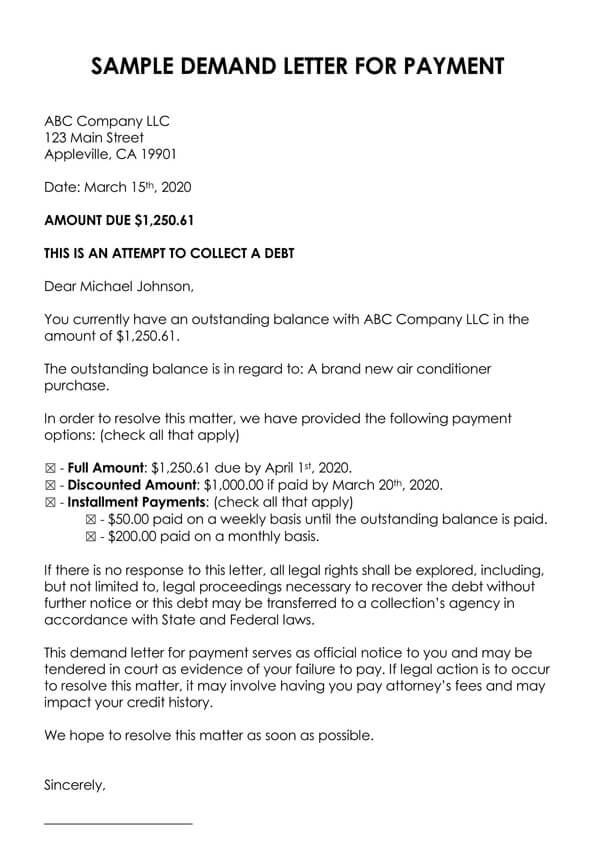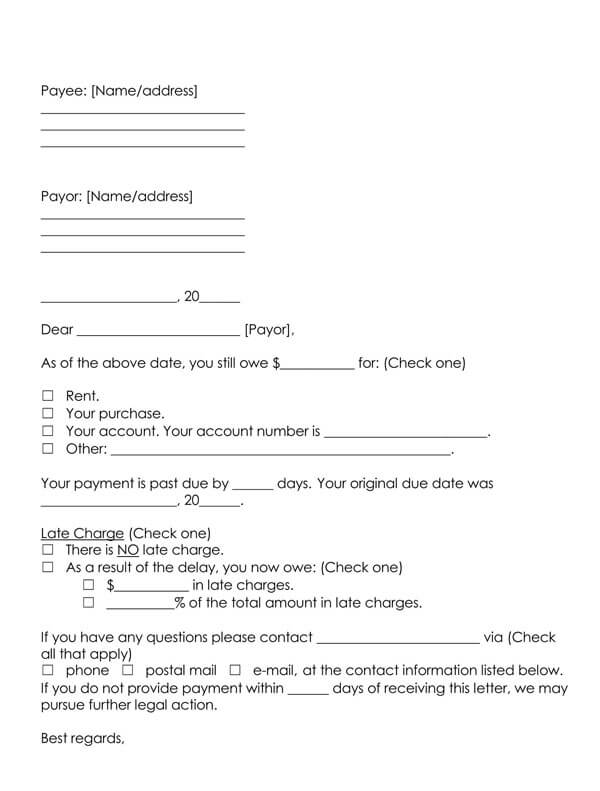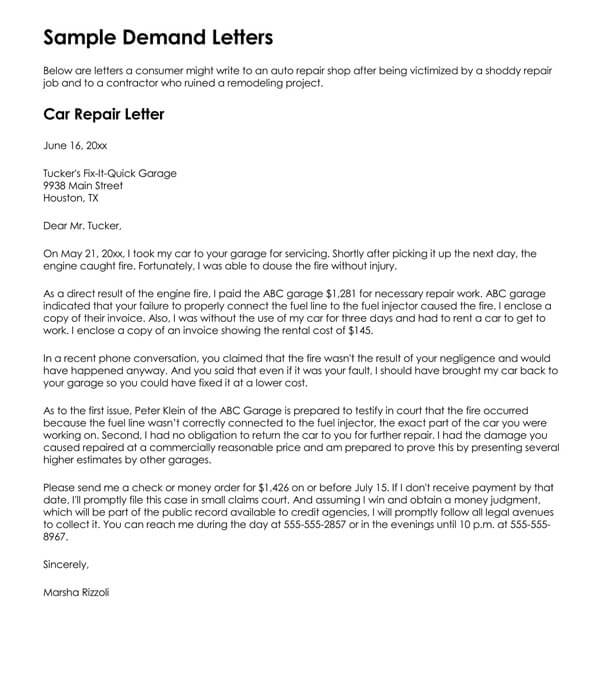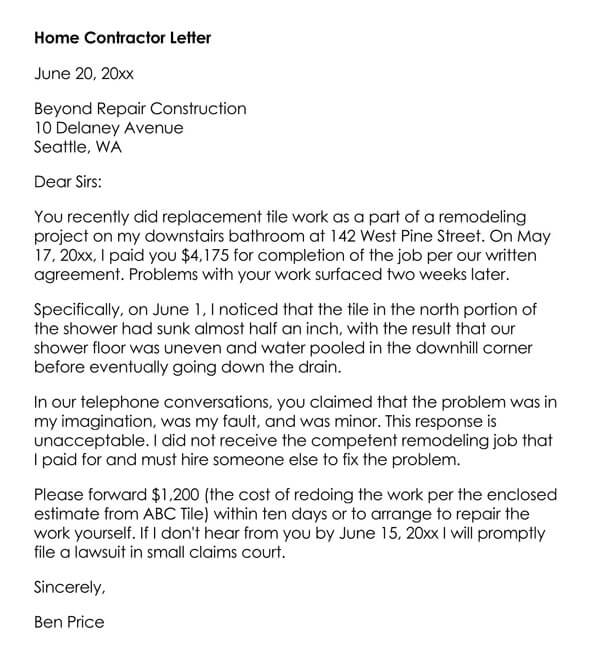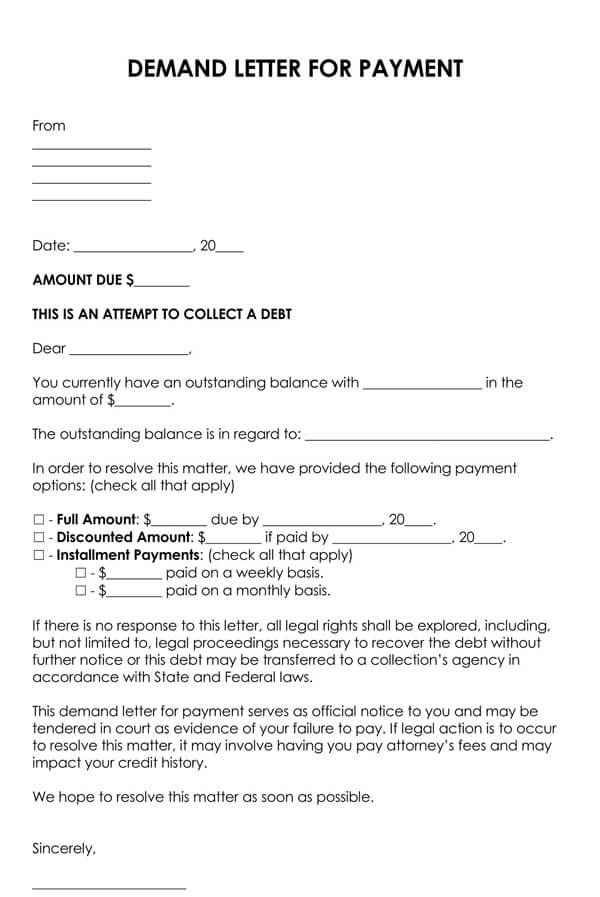A demand letter for payment is a formal notice issued to request payment owed to a creditor by a debtor. It is usually written as the final course of action before the matter is taken to a collection agency, court, or any other legal implications- should the matter goes to court, the creditor is the “plaintiff,” and the debtor is the “defendant.”
Other alternative names of a demand letter are;
- Demand for Payment Letter
- Collection letter
- Debt collection letter
- Letter of demand (LOD)
- Demand Letter for Money Owed
It outlines the expected consequences the debtor should face should they not abide by the instructions given in the demand letter
Types of Demand Letter
Before writing a demand letter for payment, you need to be aware of what to include in the letter, which will vary depending on the situation and purpose of the letter. With that in mind, it means there are different types of demand letters.
They include;
Debt owed
This is a letter written to demand money (debt) owed. It outlines the amount, due date, and reason for the debt. The demand letter for payment provides details about the debt such as the terms of the settlement, the amount expected, and interest, if any, due date, and where a creditor is willing to settle for a lesser amount; they should state so in the letter. Debt could be due to purchase, service or product provided or loan, or compensation.
Action required
A demand letter can be written to seek a party to carry out an action that was part of an agreement or is a legal obligation. In this type of demand letter, a description of the action(s) is given in detail, stating what, when, where, and how the task should be done.
Insurance claim
A demand letter can be addressed to an insurance company when a policyholder seeks compensation past its due date. The letter must show the details of the situation(e.g., accident), such as the date of the incident, claim number, and any other relevant information. The amount that is being asked should also be included.
NSF check
An NSF check is non-sufficient funds check. Occasionally, a debtor can make a payment, but the check gets returned. Due to this inconvenience, a demand letter for payment can be written to ask for the payment to be made. The information to include is details about the check, amount expected, name of the bank, and check number. Additionally, one can request reimbursement of additional charges incurred due, such as bank fees.
Stop payment
Should the debtor stop payment on a check, a demand letter can be written to request the money be paid as owed. In the letter, information such as details of the check, amount due, bank name and date issued, and check number should be provided.
When should you write a demand letter?
Ordinarily, a demand letter for payment is used when someone wants to be paid money that is owed to them. These situations are common in our day-to-day lives. Since each situation is fact-specific, every demand letter should be approached in this regard. Also, it is not in every situation one is owed money a demand letter for payment is necessary; for example, when a product or service is delivered, for example, a contractor finishes a house renovation, an invoice would be enough unless the payment is not made within the agreed time.
Another situation that would prompt a demand letter for payment is when someone was charged for a product not delivered or service not provided, and one seeks a refund.
If a phone call or other means of contact will not cut it in such a case, a demand letter for payment becomes necessary. In most cases, companies will make compensations accordingly if claims are made via phone or email. Try these means before using a demand letter. In some circumstances, compensation may be promised, but the debtor fails to keep their word. If this is so, issuing a demand letter will be necessary. Generally, a demand letter for payment becomes necessary in instances in which you have a legal claim related to the debt owed.
What if you don’t send a demand letter
If you do not issue a demand letter for payment when claiming a debt owed, you may not be able to file a lawsuit against the debtor as you never made an attempt to reach out to the debtor. A demand letter will show that the plaintiff made a formal effort to be paid, and the defendant failed to do so despite being obligated. Since a case is judged on the facts provided to the court, a demand letter for payment goes a long way in providing this as it is written from facts about the initial agreement between the creditor and the debtor.
Standard Formatting of Formal Letters to Utilise
A demand letter for payment is a document that may potentially end up being presented in court. Documents used in legal matters ought to be formally and professionally written. The following aspects characterize a standard formal letter;
- Both sender and receiver’s information, which includes their first and last names, mailing and email addresses (optional).
- The professional Font size of between 10-12 and a formally accepted font like Times New Roman
- Block formatting, which aligns text in the letter to left and single spacing.
What to Include in a Payment Demand Letter
Now to answer the question, what should be the contents of a demand letter for payment? We shall discuss its components so that when you will be writing, you can craft one that is professionally and up to standard.
Party information
This is usually the first section of the letter. It is used to identify the specific parties involved in the matter -the sender/creditor and the recipient/debtor. It includes their official names, mail, and email addresses where applicable.
The total amount expected and initial due date
The next part is the total amount owed and the date on which payment was expected. The amount should be given exactly as owed, and the date should be specifically indicating the date, month, and year. In the case where the plaintiff is claiming services were not rendered, the tasks should be given in detail in this section.
A detailed description of the reason
Following the amount owed are details of the debt, such as how it came to be. Simply put, it is the reason why the creditor is legally obligated to demand payment. This could be as an agreement, purchase, service rendered, or complaint about a refund. Where previous attempts to collect such as phone calls or emails were made, they should be discussed in this section.
The date when the full amount is due
This section outlines the expected amount and when it is expected. It should be descriptive and the amount stated in figures. The actual date when the creditor expects payment should be given.
A threat
This section is used to “scare” the debtor into making payment. It highlights the consequences of adhering to the demand laid out in the demand letter for payment. It includes legal actions such as forwarding the issue to a collection agency or filing a case in court. It is important to note that despite the letter’s demanding nature, always try to keep it polite.
An incentive for the debtors
This section is meant to give the debtor motivation to make payment. Incentives could be in the form of giving a discount, payment plan or giving a revised due date. Incentives are important as sometimes the debtor could be willing to pay but does not have the full amount at the moment, and getting to pay part of the money or having an extension will boost their chances of getting the money.
Closing and signature
At the end of the letter, please provide contact information should they need to contact you and sign off. This marks the end of a wholly written demand letter for payment.
How to Send a Demand Letter for Payment?
In most cases, it is in everyone’s interest that the matter does not go to court, so you always want the demand letter to get to the debtor and be as effective as possible. The process from when the debtor defaults on payment to payment can be described in a few steps.
The steps include:
Step 1: Gathering evidence of debt
A demand letter for payment should be based on factual evidence of an agreement. Always ensure that you are legally allowed to claim the said amount. This evidence can be presented by attaching exhibits such as the contract number, receipts, invoices, or other proof of sale.
Step 2: Writing the demand letter
Coming up with a strategy beforehand can be a good way to motivate the debtor to pay. Research on inclusions such as “threats” or “incentives” you give to ensure you get your dues.
Some of the ways you can force a return of payment are through;
- Collection’s agency: Forwarding the matter to a collection agency would automatically affect the debtor’s credit. Threatening them of involving a collection agency can be attention-grabbing, prompting the debtor to reach out or make payments.
- Discount: Sometimes, the debtor cannot raise the full amount at that time, and offering a discount can be pretty motivating. Giving a deadline for a discount and indicating it is a one-time offer can go a long way to ensure you get paid as the debtor will be motivated to act fast to ensure they make use of the discount.
- Installment payments: Giving the debtor an option of partial payments can be motivating, especially when the issue is their inability to raise the full amount at once.
- Small claims: If the debt is eligible for litigation according to local, state, or federal laws, threatening the debtor with seeking legal action through a small claims court can force their hand to make payment.
Step 3: Sending in the mail
It is recommended that demand letters be sent through the USPS’ (United States Postal Services’) certified mail and with a Return receipt. “Certified mail” is a term trademarked by USPS that is required by the sender (creditor in this case) to inform the debtor of the money they owe. The “Return receipt” is used when the sender needs proof from USPS of when the letter was delivered and who received it. It is normally a log with the receiver’s name and signature.
Other options for sending the demand letter for payment are;
- Personally, delivering the letter.
- Using a lawyer to send it on your behalf
- Using a family member or trusted friend
Email or text is not recommended as legally; it does not provide proof of delivery.
Step 4: Commence legal proceedings
Should there be no response or payment from the debtor, the creditor is well within their rights to take the matter to court or seek legal intervention.
This can be realized in one of the following ways;
- Forwarding the debt to a collection agency: Recommended for businesses with many debtors as the cost of litigation for every debtor may exceed the debts. Also, it is advantageous in that collection agencies charged after collecting, normally 25-50%.
- Filing a case in a small claims court: If the amount falls within the state-mandated maximum amount, a small claims court can be used. This is effective for personal debts and is also fast; usually, a court date is given within 30 days.
- Use of district/superior court: Applicable for debts larger than the maximum allowed for a small claims court. It requires the use of an attorney.
Types of Response to Expect
Ordinarily, after issuing a demand letter for payment, the debtor should get back as a gesture of good faith and their commitment to the agreement.
The various ways they can do this include;
Acknowledge the issue and comply with your request
Sometimes, a demand letter can be all the motivation that a debtor needed for them to make payment, as more often, people do not wish to be taken to court. They can respond to the demand letter making payment due.
Reply with a counteroffer
In other instances, a debtor can reply with a counteroffer if they are unsatisfied with the terms or are willing to make payments provided adjustments are made to your offer. This could be in terms of the amount, terms, or payment plan. This is usually an opportunity for negotiation.
Ignore your letter
Should you get no response by the due date stipulated in your letter, choose to reach out to the debtor through other means or another letter or proceed to legal action.
What is a Settlement?
Settlement is payment made with compromise, for example, a discount or deduction. It means the creditor receives less money than they were initially owed.
With the cost of litigation and time consumed to settle debts, a settlement will sometimes be a better option. It ensures that you get paid on time, or you at least get a portion of what was owed rather than losing the entire amount or having to wait long before payment is made.
You may be wondering, how long after sending a demand letter for payment can someone be offered a settlement? Well, that will vary from one person to person and the situation at hand. Some recipients might take longer while others might pay up immediately, and in other cases, the issue might just have to go to court. One can include terms for the debtor to accept or reject to eliminate the back ad forths to accelerate the resolution.
So, with all that information provided, how should a typical demand letter for payment look like? Below is a demand letter template accompanied by a sample for you to go through and have a general overview of a demand letter.
Demand Letter For Payment Template
[DATE]
[CREDITOR]
[STREET ADDRESS]
[CITY][STATE][ZIP]
[DEBTOR]
[STREET ADDRESS]
[CITY][STATE][ZIP]
Dear Mr./Mrs [the debtor],
Re: This is an attempt to collect/debt/invoice
I am writing this letter to inform you that the invoice payment [serial no.] issued on [date] is past its due date [date] as agreed on upon.
You purchased [product details] amounting to [total cost]. I have attached a copy of the invoice. I am hereby requesting that you pay the stated amount by [due date]. Kindly be aware that failure to do so will leave me no choice but to take legal action regarding the matter. Should this be the case, any legal fees accrued will be added to the amount already owed.
If you have any pending inquiries or wish to reach me, kindly do so through [contact information].
Sincerely,
[Signature]
[Sender’s/Creditor’s Name]
Demand Letter for Payment Sample
Jameson Retail Store.
567 North Street,
Greensville, PA 18022,
12th February 2021
Harrison Maine,
981 Highroad Ave,
Greensville, PA 1802
Dear Mr. Maine,
Re: THIS IS AN ATTEMPT TO COLLECT A DEBT
We would like to remind you that you still haven’t made payments for invoice 722G038 (attached) dated 1st February.
Your outstanding debt is $1200 for the four desktop monitors, each valued at $300. To resolve this issue, we have outlined payment options for you to consider.
i. The full amount ($1200) is due by 1st March 2021
ii. Discounted amount ($1050) to be paid before 25th February 2021
iii. Payment by installments as follows; weekly installments of $400 until the payment is fully paid.
Kindly ensure you get back to us as failure to do so will be treated as a rejection of our offers, and all possible legal options will be explored. This letter is the final attempt, outside legal means, to recoup the money.
If you have any queries or wish to reach me, kindly do so through (022) 3844-1900.
Sincerely,
[Signature]
Manager
Free Downloads
The application of a demand letter is in events that happen in our everyday life. At some instant, most people will find themselves in need of one when collecting a debt. Due to its formal nature, it can be tasked to come up with one. This necessitates the use of a demand letter for payment template as a guide. We have provided free downloadable demand letter for payment templates for you to download and customize to fit your situation. Kindly download.
In some cases, a demand letter for payment could be your only chance of ever getting paid. Before taking a debt claim to court, always try other options such as a demand letter, phone calls, etc. If none of these methods is yielding any results, you are legally eligible to make file a case in court. A demand letter for payment will customarily include both parties’ information, debt expected, description of the reason(s), threats and incentives, and the creditor’s signature. Ensure the demand letter for payment is professionally written as it can potentially be provided as evidence in a court of law. All the best.
Frequently Asked Questions
Is the demand letter for payment just a form of threat intended to compel the other side to pay up?
No. It is used to try and reach a civilized solution of settling debts outside court. It outlines the potential consequences of not paying up and offers settlement as an option rather than going to court.
Should I keep a copy of the letter for my own records?
Yes. Remember should the issue go to court, you are expected to produce it as evidence, and if you have a copy will help should the debtor claim they never received it.
What method of delivery should I use?
It is advisable to use certified mail wherever possible. Other methods are hard to prove that the debtor received the letter.
